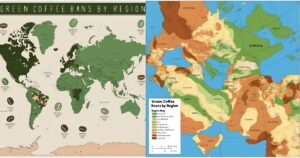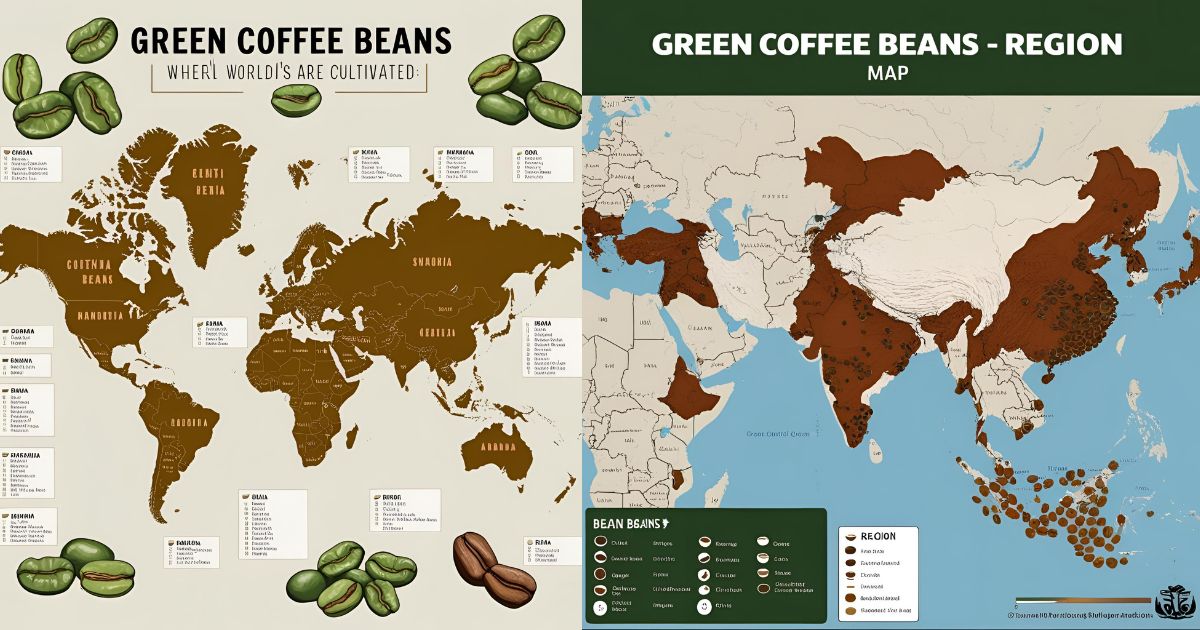Last updated on July 20th, 2025 at 09:46 pm
Most people drink coffee without ever thinking about where it comes from—or how much that origin shapes the taste in their cup.
The truth? A bean grown in Ethiopia tastes wildly different from one harvested in Colombia.
That’s because green coffee beans by region map isn’t just a fun graphic—it’s the key to unlocking rich, complex coffee flavor profiles tailored to your taste.
Altitude, soil, climate, and even harvest methods all impact how a coffee bean develops before it’s ever roasted. Understanding these coffee-growing regions gives you a serious edge—whether you’re brewing at home, buying green beans, or simply chasing better flavor.
In this guide, you’ll get a world-class breakdown of green coffee origins by continent, flavor notes by region, and an easy-to-read global map that connects the dots.
Want to know which regions produce fruity, floral coffees? Or where to find bold, earthy beans perfect for espresso? This is where it all starts.
Scroll down and discover the world of coffee from the ground up—literally.
World Coffee Belt: Where Green Coffee Beans Are Grown
If you want to understand why your coffee tastes the way it does, you need to start with geography.
Coffee beans don’t grow just anywhere—they thrive in a specific zone called the Coffee Belt.
This region wraps around the globe, stretching between the Tropics of Cancer and Capricorn. It’s home to the world’s top coffee-producing countries, and it’s where your favorite beans begin their journey.
Understanding the Coffee Belt (Tropics of Cancer & Capricorn)
The Coffee Belt covers over 70 countries with just the right altitude, temperature, and rainfall to grow high-quality green coffee beans.
Think of it as Earth’s perfect brewing zone—every country within it brings something unique to your cup.
From the bright, floral notes of Ethiopia to the chocolatey richness of Brazil, the Coffee Belt explains it all.
Key Factors Affecting Bean Quality by Region
Let’s break down what truly shapes your coffee’s character—beyond just country names.
Altitude
Higher altitudes produce slower-growing beans, which develop more complex flavors and brighter acidity. That’s why mountain-grown coffee often tastes cleaner and more refined.
Soil & Climate
The coffee terroir—a blend of soil type, temperature, and humidity—has a direct impact on bean density and taste. Volcanic soil? Expect bold, deep notes. Dry climate? More concentrated flavors.
Varietals
Different coffee varietals (like Bourbon, Typica, or SL-28) offer different taste profiles, even when grown side by side. Origin and genetics work together to create flavor diversity.
Harvest Methods
Hand-picked or machine harvested? Washed, honey-processed, or natural? These growing conditions and post-harvest methods change the texture, aroma, and even the sweetness of the final brew.
Interactive Green Coffee Beans by Region Map

Now that you understand the basics, let’s get visual.
Here’s a region-by-region coffee map to help you explore the world’s most important origins—faster and smarter.
(Insert infographic or interactive map here for maximum engagement.)
How to Read the Map
Each zone is color-coded by continent or flavor profile. This makes it easy to compare beans at a glance.
Click or hover over a country (if interactive) to view:
Primary bean types
Flavor highlights
Altitude and climate info
Recommended roast levels
No guessing. Just insight.
Major Coffee-Producing Regions by Continent
Here’s a quick preview of what the map reveals:
Latin America: Think clean, balanced, chocolatey coffees from Colombia, Brazil, and Guatemala.
Africa: Expect fruity, floral, and vibrant flavors from Ethiopia, Kenya, and Rwanda.
Asia-Pacific: Earthy, bold, often spicy coffees from Indonesia, Vietnam, and Papua New Guinea.
This global breakdown helps you make better brewing decisions based on your flavor preferences—and builds your coffee IQ fast.
Ready to dive deeper into each region? Let’s explore them one by one.
Read Also:
Coffee Beans Guide:
👉 How to Make Coffee with Whole Beans
👉 Caffeine in Chocolate-Covered Coffee Beans
Latin American Origins
If you’re chasing balanced, approachable flavors, start with South American coffee. It’s where many coffee lovers fall in love with origin-specific brews.
From nutty chocolate tones to bright citrus notes, Latin America offers something for every palate.
Brazil – Nutty, Chocolatey, Low Acidity
Brazil is the world’s largest coffee exporter, and for good reason.
Green coffee from Brazil delivers a smooth, mellow cup—think milk chocolate, hazelnut, and low acidity. Perfect for espresso and dark roast fans who want richness without sharpness.
The vast size and mechanized harvest methods make Brazilian beans affordable and easy to find.
Colombia – Bright, Fruity, Well-Balanced
Colombian beans are globally respected for their clean cup and juicy fruitiness.
Grown at high altitudes with careful post-harvest processing, these coffees offer a balanced blend of acidity, sweetness, and body. Ideal for pour-over or filter brew methods.
Guatemala – Floral, Cocoa, Complex Acidity
Guatemalan coffee is a favorite among specialty roasters.
Regions like Antigua and Huehuetenango produce floral aromas, cocoa undertones, and lively acidity. The country’s volcanic soil and microclimates create truly distinct origin flavors.
Peru, Honduras, Costa Rica – Under-the-Radar Gems
These countries may not dominate headlines, but they consistently deliver.
Peruvian green coffee is clean and sweet, Honduran beans are nutty and chocolate-forward, and Costa Rican coffees shine with crisp apple notes and floral finishes.
Together, they’re the hidden heroes of Latin America’s coffee scene.
African Coffee Origins
Looking for wild, complex, and fruit-forward flavors? African green coffee beans deliver in every category.
These origins are prized by third-wave roasters and flavor hunters alike.
Ethiopia – Fruity, Tea-like, Floral Aromatics
Ethiopia is coffee’s birthplace—and the flavors prove it.
Expect stone fruit, jasmine, bergamot, and tea-like clarity. Many come from wild or Ethiopian heirloom varieties grown at high altitudes and processed naturally.
If you’re into nuanced cups with floral high notes, this is where to start.
Kenya – Bold Acidity, Blackcurrant, Savory Notes
Kenyan coffee is loud—in the best way possible.
It bursts with blackcurrant, tomato, and citrus backed by crisp acidity and full body. These East African coffee beans are often double-washed, enhancing clarity and complexity.
Great for single-origin espresso or pour-over lovers who want brightness and power.
Rwanda & Tanzania – Bright, Citrus, Spicy
These lesser-known origins are full of surprises.
Rwandan coffees bring elegant citrus, floral, and tea-like tones, while Tanzanian beans offer spice, fruit, and rich body—especially from Mount Kilimanjaro-grown crops.
Their profiles often overlap with Ethiopian coffees but with a spicier twist.
Asia-Pacific & Island Coffee Origins
Prefer earthy, bold, or spicy cups? Asian green coffee is your best match.
These regions produce some of the most full-bodied, herbaceous, and uniquely processed beans on the planet.
Indonesia (Sumatra, Java) – Earthy, Full-Bodied, Herbal
Indonesian coffee beans are famous for their deep body, low acidity, and earthy complexity.
Sumatra’s wet-hulling process adds funky, herbal flavors, while Java delivers smoother, richer brews. These are ideal for darker roasts and French press drinkers.
Vietnam – Robusta Dominance, Budget-Friendly
Vietnam is the top robusta producer in the world—and its beans are strong, bitter, and highly caffeinated.
While less complex than arabica, they’re perfect for espresso blends and cold brew bases. Many roasters use Vietnamese robusta to add crema and boldness.
India & Papua New Guinea – Spicy, Unique Notes
India’s monsooned beans offer spice, wood, and mellow acidity, often found in dark blends.
Papua New Guinea produces high-altitude arabica with floral, fruity, and wine-like complexity, resembling East African coffees in character.
Whether you’re after body or nuance, these robusta vs arabica regions give you fresh angles to explore.
Comparing Coffee Flavor Profiles by Region
Understanding coffee flavor profiles by region helps you pick beans that actually match your taste preferences—not just a fancy origin name.
Let’s break it down by acidity, flavor, body, and processing—so you can decode any green coffee bean with confidence.
Acidity Levels
Acidity isn’t sourness—it’s brightness. The zing. The sparkle. And it varies by region.
Here’s what to expect:
High Acidity:
Ethiopia, Kenya, Colombia
Expect bright citrus, berry, and floral notes
Medium Acidity:
Guatemala, Costa Rica, Papua New Guinea
Balanced acidity with sweet undertones
Low Acidity:
Brazil, Sumatra, India
Smooth, mellow, and often chocolatey
Knowing this helps you avoid beans that are too sharp—or too flat—for your taste.
Flavor Notes & Body
Every region leaves a flavor fingerprint. Here’s a quick comparison:
| Region | Common Flavor Notes | Body Type |
|---|---|---|
| Ethiopia | Blueberry, jasmine, bergamot | Light |
| Kenya | Blackcurrant, tomato, citrus | Medium-Full |
| Colombia | Caramel, red fruit, nutty | Medium |
| Brazil | Chocolate, nut, mild fruit | Medium-Full |
| Sumatra | Earthy, herbal, smoky | Full |
| Guatemala | Cocoa, floral, citrus | Medium |
Use this to find your ideal green coffee bean taste before roasting or brewing.
Bean Processing Methods (Washed, Natural, Honey)
Processing methods seriously impact flavor. Here’s what you need to know:
Washed (Wet Process):
Clean, crisp, brighter acidity
Common in Kenya, Colombia, Guatemala
Natural (Dry Process):
Fruity, heavier body, more sweetness
Found in Ethiopia, Brazil
Honey Process:
Hybrid of washed & natural
Balanced sweetness and acidity
Used in Costa Rica, El Salvador
Understanding processing impact helps you match flavor to brew style—and avoid surprises.
How Region Impacts Roasting and Brewing
Where your beans come from can guide how you roast and brew for best results. Let’s simplify it.
Roasting Tips by Origin (Light, Medium, Dark)
Some beans shine bright with a light roast. Others need time in the drum to bring out depth.
Here’s what works best:
Light Roast:
Ethiopia, Kenya, Guatemala
Preserves acidity and floral/fruity notes
Medium Roast:
Colombia, Costa Rica, PNG
Balances sweetness and body
Dark Roast:
Brazil, Sumatra, India
Enhances body, reduces acidity
Use origin as your cheat sheet for roasting green coffee more effectively.
Brewing Suggestions for Different Regions
Pair your brew method with the bean’s natural profile. Here’s how:
Pour-over (African Beans):
Showcases clarity and high acidity
Perfect for Ethiopian and Kenyan beans
Espresso (Latin American Beans):
Highlights chocolate, nut, and caramel notes
Works well with Brazilian and Colombian beans
Cold Brew (Indonesian Beans):
Earthy, bold, and naturally low-acid
Ideal for Sumatra or Java beans
Brewing by origin isn’t snobbery—it’s smart. It helps you brew better coffee from the start.
Conclusion: Choose Your Green Coffee Beans by Flavor and Region
You now know that origin matters—a lot.
The region where green coffee is grown directly influences acidity, body, sweetness, and overall flavor profile. Climate, altitude, varietals, and processing all work together to shape the final taste.
Don’t settle for random beans. Explore. Compare. Experiment.
Try a fruity Ethiopian, a smooth Colombian, or an earthy Sumatran. Discover which coffee-growing region speaks to your palate.
The best part? There’s no wrong answer—just your next favorite brew waiting to be found.
FAQs About Green Coffee Beans and Regions
Have questions? You’re not alone. These quick answers clear up the confusion around origins, flavor, and regional differences.
Which country has the best green coffee beans?
It depends on your taste.
If you want bright, fruity notes, Ethiopia or Kenya is a great start. Prefer chocolatey, smooth cups? Go with Brazil or Colombia. Each origin offers something unique—there’s no one-size-fits-all “best.”
What makes Ethiopian coffee so unique?
Ethiopian green coffee beans come from heirloom varietals grown at high altitudes.
They’re often naturally processed, which boosts sweetness and fruit-forward flavors like blueberry, jasmine, and citrus. That’s why many roasters and baristas call Ethiopia the “birthplace of flavor.”
Are African or Latin beans better for espresso?
Latin American beans—like those from Brazil and Colombia—are often better for traditional espresso.
They bring body, low acidity, and chocolatey notes that work well under pressure.
However, if you want something complex and fruity, African beans can be a bold, flavorful twist in lighter roast espresso.
How do climate and altitude affect coffee flavor?
Higher altitudes mean cooler temps, which slow the bean’s growth and increase complexity.
Meanwhile, climate and soil (aka terroir) impact sweetness, acidity, and mouthfeel. That’s why the same varietal can taste wildly different in Ethiopia vs. Guatemala.

Mahian has an insatiable curiosity for discovering unique coffee beans and exploring global café trends. He delves into the stories of coffee origins, packaging innovations, and the evolving landscape of café culture. Mahian’s contributions provide readers with a broader perspective on the world of coffee.

